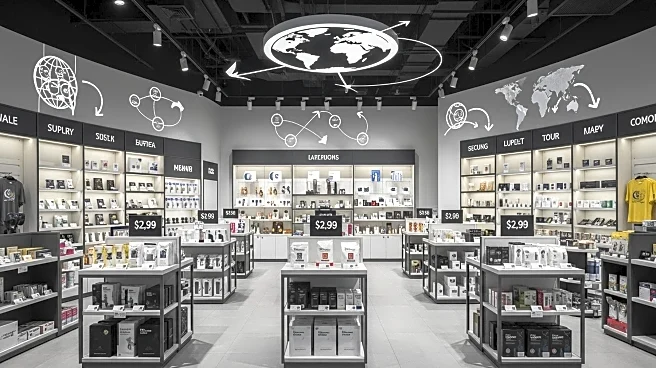What is the story about?
What's Happening?
The U.S. retail sector in 2025 is facing significant challenges due to high tariffs, which have reached their highest levels since 1934. These tariffs are reshaping pricing strategies and margin management across the industry. Retailers are responding by adopting innovative approaches to mitigate costs and maintain competitiveness. Key strategies include diversifying supply chains away from China, implementing dynamic pricing models, and enhancing operational flexibility. For instance, Best Buy has reduced its reliance on Chinese imports from 60% to under 25% by 2026, while Walmart has negotiated price cuts with Chinese manufacturers and expanded partnerships in Southeast Asia. These efforts are aimed at reducing exposure to tariff risks and enhancing resilience against geopolitical disruptions.
Why It's Important?
The high tariffs are having a profound impact on the U.S. economy, with real GDP growth projected to be 0.5 percentage points lower annually. This economic pressure is forcing retailers to innovate in cost management to sustain profitability. The average U.S. household is experiencing an annual loss of $2,400 due to tariff-driven inflation, affecting sectors like apparel and electronics. Retailers that can successfully navigate these challenges by diversifying supply chains and adopting dynamic pricing are likely to outperform their peers. Companies like Walmart and Target, which have already begun restructuring their sourcing and pricing models, are well-positioned to maintain market share and profitability.
What's Next?
Retailers will continue to focus on supply chain diversification and operational agility to mitigate the impacts of tariffs. This includes shortening supply lead times, building inventory buffers, and leveraging real-time data for opportunistic buying. Investors are advised to prioritize retailers demonstrating agility in these areas, as they are better equipped to handle the ongoing economic pressures. The sector will need to continuously adapt to the evolving trade policy landscape to ensure long-term growth and competitiveness.
Beyond the Headlines
The shift away from China-centric supply chains could have broader geopolitical implications, potentially altering global trade dynamics. Additionally, the reliance on advanced technologies for dynamic pricing and operational flexibility highlights the increasing importance of digital transformation in the retail sector. These changes may lead to a more fragmented global market, with retailers needing to balance cost management with consumer sentiment to maintain loyalty.
AI Generated Content
Do you find this article useful?















